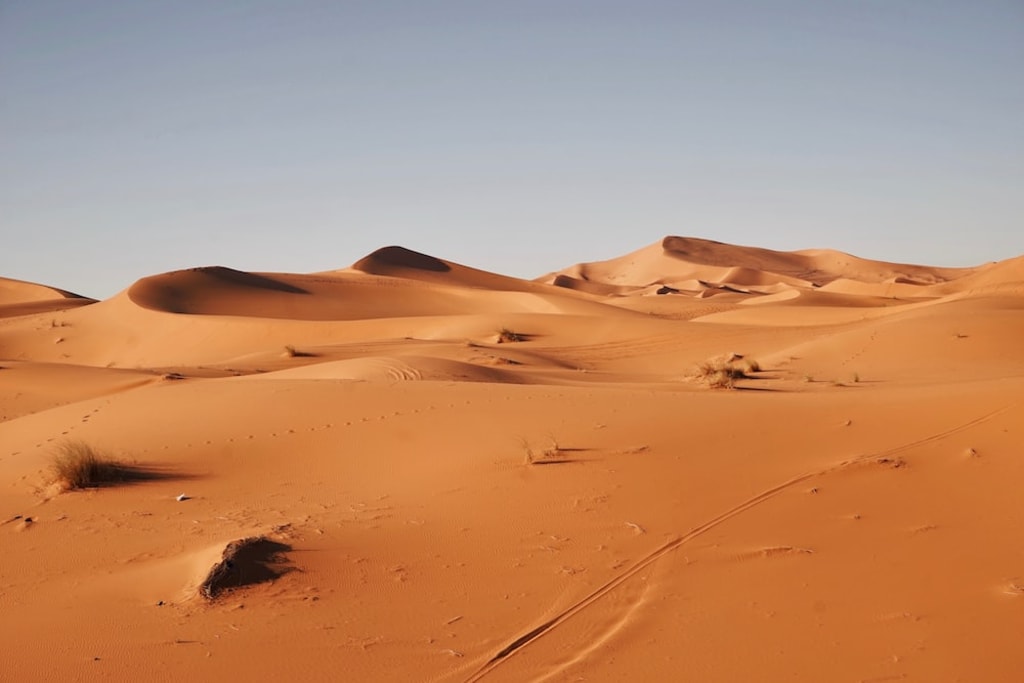what's really beneath the Sahara Desert?
The mystery of what was under the Sahara Desert

The Sahara Desert is inhospitable now, but it wasn't always like this. Secrets of the past are hidden in its sands. There are lost cities and giant lakes beneath the surface. Recent evidence suggests Atlantis may be located in the Sahara. Come with us as we uncover the hidden world beneath the desert's sands.
The Sahara is huge. It covers most of the north of Africa. The desert is one of the largest in the world, about 3.5 million square miles. What's surprising is what's under the sand. A mega lake once existed under the western Sahara, around 250,000 years ago. Evidence collected by scientists shows that the Nile River flooded the Wadi Tushka region of Egypt, covering a vast area of the Sahara. The lake was over 42,000 square miles, making it the second-largest in the world. Fish fossils were found 250 miles away from the Nile's current location. Ancient human remains were also found in the area.
The lake was crucial for our ancestors as they traveled through the arid landscape. It provided a resting place and allowed for settlements in the desert. The lake also played a key role in human migration out of Africa and into the Middle East. However, in hindsight, it might have been better if the lake never existed. Many human artifacts are buried under the Sahara Desert, and evidence of activity around the Richat Structure could be the remains of Atlantis, a highly sought-after lost city.
The Richat Structure is an impressive geologic feature with rings extending from its center, similar to how Plato described Atlantis. It is a natural feature, not manmade. It was formed by a volcano eruption and erosion. The structure is around 28 miles across and made up of igneous and sedimentary rocks. Could it be Atlantis? The problem is that Atlantis was swallowed by the sea, and the Sahara Desert is a desert with very little water. However, the Sahara was not always a desert. Maybe there was once a large body of water in the region that flooded the ancient civilization that resided within the Richat Structure. Excavations are difficult due to political and social unrest and the remoteness of the region.
Technology has made advances in archaeology. The Richat Structure has anomalies that indicate the presence of ancient buildings and artifacts. However, there is no evidence of an advanced Atlantian civilization. Many believe the concentric circles match Plato's description of Atlantis, but academics are skeptical. The secrets in this part of the Sahara will remain a mystery until more research is done. Countless other archaeological digs in the Sahara have uncovered incredible artifacts. Satellites have helped archaeologists identify what lies under the sands. The Garamantes civilization was once lost but has been uncovered. They built giant forts and settlements thousands of years ago. The Sahara has reclaimed the settlements, but artifacts show the power of this native African kingdom.
The Garamantes sites are densely packed with agricultural fields, cemeteries, and fortifications. This suggests a relatively large population and advanced urban planning. The Garamantes also excelled in metallurgy, manufacturing textiles, and had a unique writing system. The findings from archaeological digs reveal a state-level society in a region with little rainfall. The Garamantes transformed the desert into oases that supported entire populations and aided traders. However, their advanced irrigation methods eventually led to their downfall. As they continuously pumped water out of the ground, they bled their water sources dry. The Garamantes civilization collapsed as their vital water resource dried up, and many perished on their journey to find water. It is a lesson in human hubris buried beneath the Sahara.
People lived in the Sahara despite its harshness. Trading was necessary for survival, and larger empires desired valuable goods from across the Sahara. Timbuktu was a significant trading city, but expeditions were risky due to raiders and sandstorms. Caravans were often ambushed, and goods were lost. It's likely that vast amounts of valuable items are buried in the Sahara, but finding them would be nearly impossible. However, not all is lost.
The Valley of the Kings in the Sahara holds valuable treasures. Most of the tombs there were looted or destroyed. But there may still be secrets waiting to be uncovered. The Nile River was crucial to the wealth and power of Ancient Egypt. Despite this, many impressive monuments were built in the desert. The Pharos needed secure and elaborate tombs. The Temple of Hatshepsut was one such structure. It was built to be the most elegant in all of Egypt. But the sands of the Sahara reclaimed it over time. What other structures and treasures lie hidden beneath the sand?
The Sahara is full of surprises. The Kingdom of Kush, ruling from Sudan to Egypt, built pyramids and temples in the desert. These structures were built after the pyramids of ancient Egypt. Romans also left their mark in the Sahara with walls and fortifications called the Fossatum Africae. These extended over 450 miles to defend the southern border of the Roman Empire. The Sahara was important to Rome for procuring goods and exotic creatures, including animals like lions and elephants. Roman elites kept these animals as pets and used them in brutal colosseum fights. The structures buried in the Sahara were built to secure the southern boundary of the empire and ensure goods continued to flow into Rome. The most astonishing find in the Sahara isn't gold or buildings, but the realization of how different the Sahara once was.
The Sahara used to be a lush grassland and forest area 10,500 years ago. This environment was able to sustain various types of wildlife, including giraffes, elephants, rhinos, hippos, and crocodiles. But today, these animals could not survive in the Sahara for more than a few hours or days. Scientists have discovered the answer to this question by looking beneath the sands of the Sahara and above their heads at the cosmos.
Climate changes have occurred throughout Earth's history due to various factors. The wobbling of the Earth on its axis transformed the Sahara Desert into a savannah ecosystem. However, the current climate change cannot be attributed to natural phenomena. Human actions, such as the release of greenhouse gases, are causing the climate to change at an unprecedented rate. This has led to changes in climates across the planet. In contrast, the wobbling of the Earth on its axis has shifted weather patterns in the past, as seen in the Sahara 10,000 years ago.
Monsoon rains swept across the Sahara Desert, dumping water on the sands of the region. The Earth's tilt changed slightly, altering the angle of the sun's radiation hitting the atmosphere. When this happens during the West African monsoon season, it can cause rain to cover the Sahara. This phenomenon happens repeatedly due to the Earth's wobbling on its axis. The Sahara has been home to savannahs, forests, and lakes in the past, but these changes only last a few hundred years. There isn't enough time for civilizations to grow before the desert returns. However, grazers followed the rains and took advantage of the fertile environment. The Sahara turned back into a desert between 8,000 and 4,500 years ago. Some scientists believe this change happened too quickly to be explained by natural shifting alone.
The Sahara was supposed to be a savannah-type environment for much longer. But something went wrong. Researchers found an unknown variable had caused re-desertification. Scientists dug under the sands to find evidence. They collected sediment cores, pollen records, and archaeological remains. A pattern emerged. Changes began in fertile regions where humans grazed animals. Plant diversity decreased. Overgrazing caused destruction in their wake. The ground was baked and couldn't retain water. The savannah turned into the Sahara Desert. More evidence is needed. Overgrazing can have detrimental effects on grassland ecosystems. The same desertification process could occur elsewhere. It's a vicious cycle. Africa now has the third largest desert in the world. The Sahara would have turned into a desert anyway, but human activity hastened the process. Mysteries and secrets still lie beneath the sand.
About the Creator
Beulah Francis
Unconventional






Comments
There are no comments for this story
Be the first to respond and start the conversation.